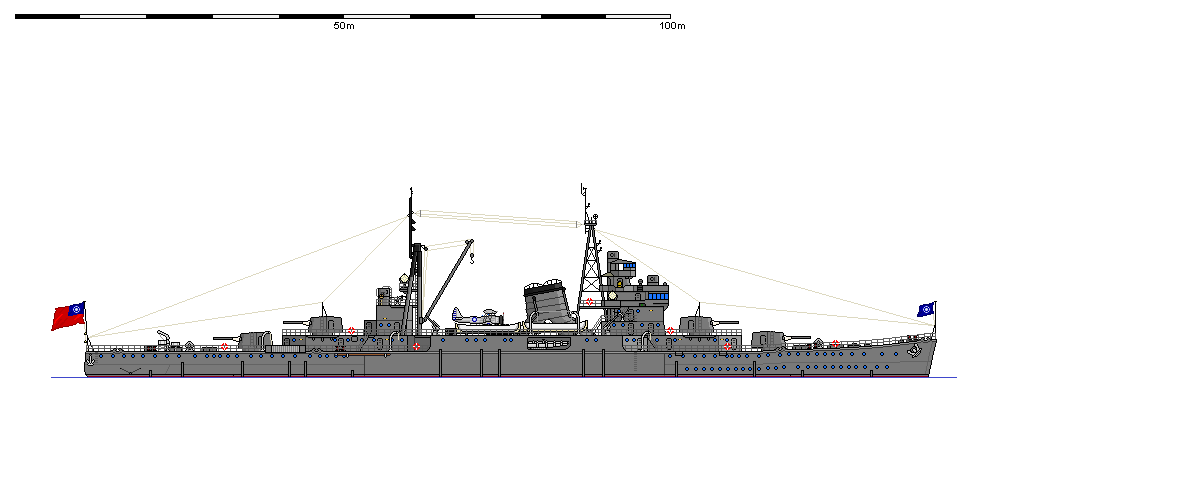Dziś nietypowy okręt – „krążownik” szkierowy, oczywiście dla Finlandii :) W założeniu ma to być okręt artyleryjski przeznaczony do działań defensywnych wśród szkierów, ale mniejszy niż pancerniki typu Vainamoinen. Dzięki małemu zanurzeniu ma mieć dużą swobodę w operowaniu na płytkich wodach, blisko wybrzeża i wśród licznych wysepek w które obfitują przybrzeżne akweny Finlandii. Zakładam, że dałby radę wpływać również tam, gdzie z racji gabarytów (głównie zanurzenia) nie dały by rady wspomniane pancerniki. Prędkość w tym wypadku nie jest najważniejsza, stąd umiarkowane 22 w. Natomiast artyleria kalibru 152 mm (produkcji szwedzkiej) ma pozwolić na bezproblemowe zwalczanie największych okrętów przeciwnika jakie w moim odczuciu mogą być w stanie zapuścić się na szkiery, czyli niszczycieli. Obronę plot. Stanowią 4 40 mm pom-pomy oraz 6 20 mm działek Madsena. Napęd, wzorem pancerników stanowią silniki diesel-elektryczne. Oczywiście, jak na „krążownik” przystało okręt ma opancerzenie (co prawda lekkie) a wymiarami, by zachować jakieś prawdopodobieństwo realizacji - nie przekracza ówczesnego niszczyciela.
Turunmaa, finnish coast defence gunboat laid down 1935 (Engine 1936)
Displacement:
1 243 t light; 1 348 t standard; 1 436 t normal; 1 506 t full load
Dimensions: Length overall / water x beam x draught
308,38 ft / 304,27 ft x 35,96 ft x 8,99 ft (normal load)
93,99 m / 92,74 m x 10,96 m x 2,74 m
Armament:
5 - 5,98" / 152 mm guns in single mounts, 107,15lbs / 48,60kg shells, 1930 Model
Quick firing guns in deck mounts
on centreline, evenly spread, 2 raised mounts
4 - 1,57" / 40,0 mm guns in single mounts, 1,95lbs / 0,88kg shells, 1918 Model
Anti-aircraft guns in deck mounts
on centreline, all amidships, all raised mounts - superfiring
6 - 0,79" / 20,0 mm guns in single mounts, 0,24lbs / 0,11kg shells, 1930 Model
Anti-aircraft guns in deck mounts
on side, all amidships, all raised mounts - superfiring
Weight of broadside 545 lbs / 247 kg
Shells per gun, main battery: 250
Armour:
- Belts: Width (max) Length (avg) Height (avg)
Main: 1,97" / 50 mm 100,43 ft / 30,61 m 8,99 ft / 2,74 m
Ends: Unarmoured
Main Belt covers 51% of normal length
Main belt does not fully cover magazines and engineering spaces
- Gun armour: Face (max) Other gunhouse (avg) Barbette/hoist (max)
Main: 1,18" / 30 mm 0,79" / 20 mm -
- Armour deck: 0,98" / 25 mm, Conning tower: 1,18" / 30 mm
Machinery:
Diesel Internal combustion generators plus batteries,
Electric motors, 2 shafts, 7 640 shp / 5 699 Kw = 22,00 kts
Range 3 000nm at 13,00 kts
Bunker at max displacement = 158 tons
Complement:
116 - 151
Cost:
£0,666 million / $2,662 million
Distribution of weights at normal displacement:
Armament: 68 tons, 4,7%
Armour: 247 tons, 17,2%
- Belts: 87 tons, 6,1%
- Torpedo bulkhead: 0 tons, 0,0%
- Armament: 23 tons, 1,6%
- Armour Deck: 134 tons, 9,3%
- Conning Tower: 3 tons, 0,2%
Machinery: 214 tons, 14,9%
Hull, fittings & equipment: 713 tons, 49,7%
Fuel, ammunition & stores: 193 tons, 13,4%
Miscellaneous weights: 0 tons, 0,0%
Overall survivability and seakeeping ability:
Survivability (Non-critical penetrating hits needed to sink ship):
2 357 lbs / 1 069 Kg = 22,0 x 6,0 " / 152 mm shells or 0,9 torpedoes
Stability (Unstable if below 1.00): 1,39
Metacentric height 1,9 ft / 0,6 m
Roll period: 10,9 seconds
Steadiness - As gun platform (Average = 50 %): 51 %
- Recoil effect (Restricted arc if above 1.00): 0,26
Seaboat quality (Average = 1.00): 1,02
Hull form characteristics:
Hull has a flush deck
Block coefficient: 0,511
Length to Beam Ratio: 8,46 : 1
'Natural speed' for length: 17,44 kts
Power going to wave formation at top speed: 54 %
Trim (Max stability = 0, Max steadiness = 100): 50
Bow angle (Positive = bow angles forward): 10,00 degrees
Stern overhang: 2,00 ft / 0,61 m
Freeboard (% = measuring location as a percentage of overall length):
- Stem: 11,98 ft / 3,65 m
- Forecastle (17%): 10,47 ft / 3,19 m
- Mid (50%): 9,48 ft / 2,89 m
- Quarterdeck (19%): 10,01 ft / 3,05 m
- Stern: 10,47 ft / 3,19 m
- Average freeboard: 10,14 ft / 3,09 m
Ship tends to be wet forward
Ship space, strength and comments:
Space - Hull below water (magazines/engines, low = better): 87,8%
- Above water (accommodation/working, high = better): 119,2%
Waterplane Area: 7 363 Square feet or 684 Square metres
Displacement factor (Displacement / loading): 118%
Structure weight / hull surface area: 67 lbs/sq ft or 328 Kg/sq metre
Hull strength (Relative):
- Cross-sectional: 1,21
- Longitudinal: 1,65
- Overall: 1,25
Hull space for machinery, storage, compartmentation is adequate
Room for accommodation and workspaces is adequate
Turunmaa (1936)
Hamenmaa (1937)
Pohjanmaa (1938)



















































